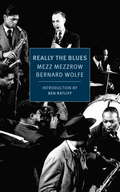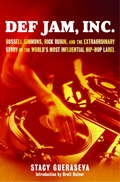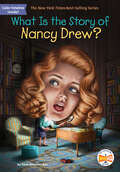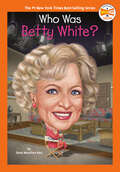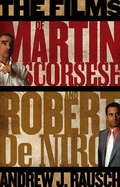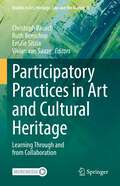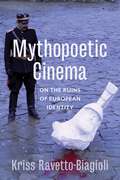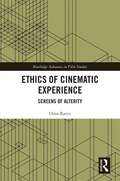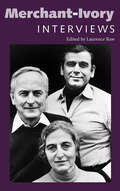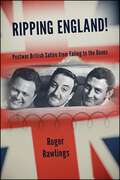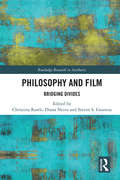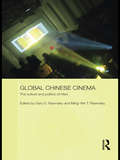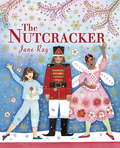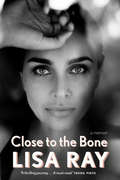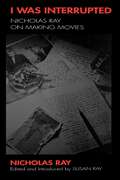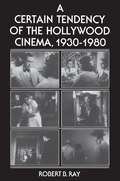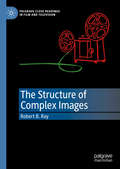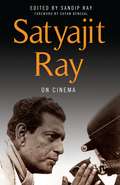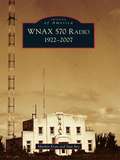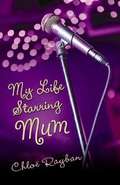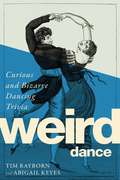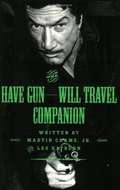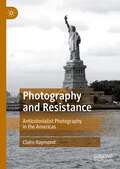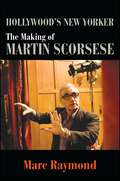- Table View
- List View
Really the Blues
by Ben Ratliff Mezz Mezzrow Bernard WolfeMezz Mezzrow was a Jewish boy from the slums of Chicago who learned to play the clarinet in reform school and pursued a life in music and a life of crime. He moved from Chicago to New Orleans to New York, working in brothels and bars, bootlegging, dealing drugs, getting hooked, doing time, producing records, and playing with the greats, among them Louis Armstrong, Bix Beiderbecke, and Fats Waller. Really the Blues, the jive-talking memoir that Mezzrow wrote at the insistence of, and with the help of, the novelist Bernard Wolfe, is the story of an unusual and unusually American life, and a picture of a man who moved freely across racial boundaries when few could or did, "the odyssey of an individualist. . . the saga of a guy who wanted to make friends in a jungle were everyone was too busy making money."
Def Jam, Inc.: Russell Simmons, Rick Rubin, and the Extraordinary Story of the World's Most Influential Hip-hop Label
by Brett Ratner Stacy GuerasevaIn the early '80s, the music industry wrote off hip-hop as a passing fad. Few could or would have predicted that the improvised raps and raw beats busting out of New York City's urban underclass would one day become a multimillion-dollar business and one of music's most lucrative genres. Among those few were two visionaries: Russell Simmons, a young black man from Hollis, Queens, and Rick Rubin, a Jewish kid from Long Island. Though the two came from different backgrounds, their all-consuming passion for hip-hop brought them together. Soon they would revolutionize the music industry with their groundbreaking label, Def Jam Records.Def Jam, Inc. traces the company's incredible rise from the NYU dorm room of nineteen-year-old Rubin (where LL Cool J was discovered on a demo tape) to the powerhouse it is today; from financial struggles and scandals-including The Beastie Boys's departure from the label and Rubin's and Simmons's eventual parting-to revealing anecdotes about artists like Slick Rick, Public Enemy, Foxy Brown, Jay-Z, and DMX. Stacy Gueraseva, former editor in chief of Russell Simmons's magazine, Oneworld, had access to the biggest players on the scene, and brings you real conversations and a behind-the-scenes look from a decade-and a company-that turned the music world upside down. She takes you back to New York in the '80s, when late-night spots such as Danceteria and Nell's were burning with young, fresh rappers, and Simmons and Rubin had nothing but a hunch that they were on to something huge.Far more than just a biography of the two men who made it happen, Def Jam, Inc. is a journey into the world of rap itself. Both an intriguing business history as well as a gritty narrative, here is the definitive book on Def Jam--a must read for any fan of hip-hop as well as all popular-culture junkies.
What Is the Story of Nancy Drew? (What Is the Story Of?)
by Dana M. Rau Who HQUncover the mystery of Nancy Drew and how the beloved teenage detective came to be in this new addition to the What Is the Story Of? series which follows the same format as the #1 New York Times Best-Selling Who Was? series.When the very modern character of Nancy Drew first appeared in 1930, no one had a clue that she would remain a star for the next century! To this day, Nancy is still the main character in new TV shows, movies, and books. What makes her so interesting to so many generations of readers? Nancy can do it all! She's a daring teenage girl who solves mysteries, expertly drives her famous blue car, cooks like a gourmet chef, swims like a pro, and more! Since her first appearance, the prodigy detective has inspired young readers to believe that they can do it all, too.
Who Was Betty White? (Who HQ Now)
by Dana Meachen Rau Who HQLearn about the remarkable life of actress and comedian Betty White, a pioneer of early television with a seven-decade career, in this title in the Who HQ Now series featuring newsmakers and trending topics.From 1939 to 2021, actress Betty White was one of the most beloved performers in the entertainment industry. She starred in fan-favorite television shows like The Golden Girls and The Mary Tyler Moore Show, and also blockbuster movies like Toy Story 4 and The Proposal. Over her decades-long career, Betty White won Emmy awards, was named an honorary mayor of Hollywood, earned a star on the Walk of Fame, and set the Guinness World Record for woman with the longest TV career ever. Off-screen, Betty advocated for animal rights, racial justice, and LGBTQIA+ rights. Learn about her legendary life in this book for young readers.
The Films of Martin Scorsese and Robert De Niro
by Andrew J RauschIn 1973, early in their careers, Martin Scorsese and Robert De Niro collaborated for the first time. Over the next few decades, they worked together on seven more movies, many of which brought them both acclaim and awards. And while successful director and actor pairings have occurred throughout the history of film, few have fashioned so many works of enduring value as these two artists. In little more than two decades, Scorsese and De Niro produced eight features, including the classics Taxi Driver, Raging Bull, and GoodFellas. In The Films of Martin Scorsese and Robert De Niro, Andrew J. Rausch examines the creative output of this remarkable pair, from their initial offering, Mean Streets, to their most recent film together, Casino. Rausch looks at their relationship as individual artists who worked together to create cinematic magic, as well as the friendship that was forged nearly 40 years ago. Drawing upon interviews and other sources, Rausch goes behind the scenes of their eight films, providing insi
Participatory Practices in Art and Cultural Heritage: Learning Through and from Collaboration (Studies in Art, Heritage, Law and the Market #5)
by Christoph Rausch Ruth Benschop Emilie Sitzia Vivian Van SaazeThis edited volume analyzes participatory practices in art and cultural heritage in order to determine what can be learned through and from collaboration across disciplinary borders. Following recent developments in museology, museum policies and practices have tended to prioritize community engagement over a traditional focus on collecting and preserving museal objects. At many museal institutions, a shift from a focus on objects to a focus on audiences has taken place. Artistic practices in the visual arts, music, and theater are also increasingly taking on participatory forms. The world of cultural heritage has seen an upsurge in participatory governance models favoring the expertise of local communities over that of trained professionals. While museal institutions, artists, and policy makers consider participation as a tool for implementing diversity policy, a solution to social disjunction, and a form of cultural activism, such participation has also sparked a debate on definitions, and on issues concerning the distribution of authority, power, expertise, agency, and representation. While new forms of audience and community engagement and corresponding models for “co-creation” are flourishing, fundamental but paralyzing critique abounds and the formulation of ethical frameworks and practical guidelines, not to mention theoretical reflection and critical assessment of practices, are lagging.This book offers a space for critically reflecting on participatory practices with the aim of asking and answering the question: How can we learn to better participate? To do so, it focuses on the emergence of new norms and forms of collaboration as participation, and on actual lessons learned from participatory practices. If collaboration is the interdependent formulation of problems and entails the common definition of a shared problem space, how can we best learn to collaborate across disciplinary borders and what exactly can be learned from such collaboration?
Mythopoetic Cinema: On the Ruins of European Identity
by Kriss Ravetto-BiagioliIn Mythopoetic Cinema, Kriss Ravetto-Biagioli explores how contemporary European filmmakers treat mythopoetics as a critical practice that questions the constant need to provide new identities, a new Europe, and with it a new European cinema after the fall of the Soviet Union. Mythopoetic cinema questions the perpetual branding of movements, ideas, and individuals. Examining the work of Jean-Luc Godard, Alexander Sokurov, Marina Abramović, and Theodoros Angelopoulos, Ravetto-Biagioli argues that these disparate artists provide a critical reflection on what constitutes Europe in the age of neoliberalism. Their films reflect not only the violence of recent years but also help question dominant models of nation building that result in the general failure to respond ethically to rising ethnocentrism.In close readings of such films as Sokurov's Russian Ark (2002) and Godard's Notre Musique (2004), Ravetto-Biagioli demonstrates the ways in which these filmmakers engage and evaluate the recent reconceptualization of Europe's borders, mythic figures, and identity paradoxes. Her work not only analyzes how these filmmakers thematically treat the idea of Europe but also how their work questions the ability of the moving image to challenge conventional ways of understanding history.
Ethics of Cinematic Experience: Screens of Alterity (Routledge Advances in Film Studies)
by Orna RavivEthics of Cinematic Experience: Screens of Alterity deals with the relationship between cinema and ethics from a philosophical perspective, finding an intrinsic connection between film spectatorship and the possibility of being open to different modes of alterity. The book’s main thesis is that openness to otherness is already found in the basic structures of cinematic experience. Through a close examination of the ethical relevance of the philosophy of Maurice Merleau-Ponty, Stanley Cavell, Emmanuel Levinas and Gilles Deleuze to cinema studies, Ethics of Cinematic Experience: Screens of Alterity pursues the question of how film can open the viewer to what is not her, and so bring her to encounter otherness in a way that is unique to cinematic experience. The book sees ethics as not just the subject, content or story of a film but part of its aesthetic structure. Accompanied by readings of films mainly from mainstream cinema, each chapter focuses on a different aspect of the encounter with alterity through cinema. The book gives particular attention to how theoretical discussion of the cinematic close-up can lead to ethical insights into the status of both the human and the non-human in film, and thus lead to an understanding of the relationships the viewer makes with them. The book is a helpful resource for students and scholars interested in the relationship between philosophy, film and ethics, and is appropriate for students of philosophy and media and cultural studies.
Merchant-Ivory: Interviews (Conversations with Filmmakers Series)
by Laurence RawMerchant-Ivory: Interviews gathers together, for the first time, interviews made over a span of fifty years with director James Ivory (b. 1928), producer Ismail Merchant (1936–2005), and screenwriter Ruth Prawer Jhabvala (1927–2013). Beginning with their earliest work in India, and ending with James Ivory's last film, The City of Your Final Destination (2009), the book traces their career, while offering valuable insights into their creative filmmaking process. The volume serves as a corrective to the prevailing critical orthodoxy attached to Merchant-Ivory's work, which tends to regard them as being solely concerned with historically accurate costumes and settings. As independent filmmakers, they have developed an idiosyncratic approach that resists facile classification. Merchant-Ivory have insisted on maintaining their independence. More importantly, this book shows how Merchant-Ivory have always taken considerable care in casting their films, as well as treating actors with respect. This is a deliberate policy, designed to bring out one of the triumvirate's principal thematic concerns, running throughout their work—the impact of the “clash of cultures” on individuals. Partly this has been inspired by their collective experiences of living and working in different cultures. They do not offer any answers to this issue; rather they believe that their task is simply to raise awareness; to make filmgoers conscious of the importance of cultural sensitivities that assume paramount significance in any exchange, whether verbal or nonverbal.
The View from Babylon: The Notes of a Hollywood Voyeur
by Donald RawleyRawley paints the definitive portrait of Hollywood in the '90s. A lifelong L.A. inhabitant, Rawley takes you on a tour beyond the city's edge - from Malibu's shining white beaches to lonely desert communities to big-studio arenas where life speeds by in "Hollywood time." He introduces a memorable cast of characters - a wistful, recovering methamphetamine addict; a loving father and dedicated ex-soldier driven by heartbreaking failure; the always glamorous, never satisfied Hollywood denizens at one of the industry's "big-big-big" premieres. The View from Babylon is a portrait of the city that reflects our deepest dreams and darkest desires.
Ripping England!: Postwar British Satire from Ealing to the Goons (SUNY series, Horizons of Cinema)
by Roger RawlingsRipping England! investigates a fertile moment for British satire—the period between 1947 and 1953, which produced the films Passport to Pimlico, Kind Hearts and Coronets, and The Lavender Hill Mob, as well as the seminal radio program The Goon Show. Against the postwar background of fading empire, universal rationing, and the implementation of a welfare state, these satires laid the foundation for a new British cultural identity later fleshed out by the Angry Young Men, the Movement poets, the Social Realists, and those involved in the satire boom of the 1960s, which lives on even to this day.The peculiarity of these satires and the British identity they shaped is better understood when seen in relief against postwar cinematic cultures of Italy, France, and the United States. Roger Rawlings places postwar British film in the context of contemporaneous European national film movements and contrasts it with Hollywood's comedies and satires of the same period. British satires of the late forties and early fifties held up a mirror to a nation that was in the throes of change, moving from a colonial empire to an inward-turning island culture. Ripping England! looks at the all too often neglected miracle of postwar British cinema and popular culture.
Philosophy and Film: Bridging Divides (Routledge Research in Aesthetics)
by Christina Rawls Diana Neiva Steven S. GouveiaThis volume collects twenty original essays on the philosophy of film. It uniquely brings together scholars working across a range of philosophical traditions and academic disciplines to broaden and advance debates on film and philosophy. The book includes contributions from a number of prominent philosophers of film including Noël Carroll, Chris Falzon, Deborah Knight, Paisley Livingston, Robert Sinnerbrink, Malcolm Turvey, and Thomas Wartenberg. While the topics explored by the contributors are diverse, there are a number of thematic threads that connect them. Overall, the book seeks to bridge analytic and continental approaches to philosophy of film in fruitful ways. Moving to the individual essays, the first two sections offer novel takes on the philosophical value and the nature of film. The next section focuses on the film-as-philosophy debate. Section IV covers cinematic experience, while Section V includes interpretations of individual films that touch on questions of artificial intelligence, race and film, and cinema’s biopolitical potential. Finally, the last section proposes new avenues for future research on the moving image beyond film. This book will appeal to a broad range of scholars working in film studies, theory, and philosophy.
Global Chinese Cinema: The Culture and Politics of 'Hero' (Media, Culture and Social Change in Asia)
by Gary D. RawnsleyThe film Hero, directed by Zhang Yimou and released in 2002, is widely regarded as the first globally successful indigenous Chinese blockbuster. A big expensive film with multiple stars, spectacular scenery, and astonishing action sequences, it touched on key questions of Chinese culture, nation and politics, and was both a domestic sensation and an international hit. This book explores the reasons for the film’s popularity with its audiences, discussing the factors which so resonated with those who watched the film. It examines questions such as Chinese national unity, the search for cultural identity and role models from China’s illustrious pre-communist past, and the portrayal of political and aesthetic values, and attitudes to gender, sex, love, and violence which are relatively new to China. The book demonstrates how the film, and China’s growing film industry more generally, have in fact very strong international connections, with Western as well as Chinese financing, stars recruited from the East Asian region more widely, and extensive interactions between Hollywood and Asian artists and technicians. Overall, the book provides fascinating insights into recent developments in Chinese society, popular culture and cultural production.
The Nutcracker
by Jane RayThe ultimate children's gift edition of the beloved classic ballet story, The Nutcracker.Christmas Eve is the most magical night of the year, when the house is scented with wood smoke and spices, and there are secrets under every bed . . . When the clock strikes midnight, Clara's new nutcracker doll comes to life and leads her on a thrilling adventure, battling with the wicked Mouse King and his troops, then journeying to the Kingdom of Sweets. Retold simply and lyrically, with enchanting illustrations that capture all the joy and excitement of Christmas, this beautiful book from award-winning book-maker Jane Ray, this is the ultimate contemporary edition of everyone's favourite Christmas ballet story!
Close to the Bone: A Memoir
by Lisa Ray&“A thrilling journey. . . . A must-read.&” Freida Pinto &“How fortunate a thing it is, when life alters you without warning.&” Lisa Ray is one of India&’s first supermodels. She&’s also an acclaimed actor, a cancer survivor, a mother of twins born through surrogacy, a lifelong student, and a person of no fixed address. She is a woman who has lived many lives. And this is her story.Unflinching and deeply moving, Close to the Bone traces Lisa Ray&’s serendipitous life, from her childhood in Canada as the biracial daughter of an Indian man and Polish woman, to her rise as a Bollywood star; from her battle with a rare and incurable cancer, to her journey to find identity and belonging, both in the world and in her own body. Transporting and atmospheric, it takes readers across the globe: Toronto in the 1970s, when Lisa was searching for place and purpose; the intense, frenetic streets of Bombay, where, young and unmoored, she became a peer of some of the biggest names in the Bollywood industry; the lush sensuality of Colombo and a film role that changed the course of her career; and in London, where she simultaneously found her footing in drama school and lost herself in an abusive relationship. It is a storied life, and one whose adventures teach Lisa that in the brightest and darkest moments, no matter where she travels to, she can always find her way back home—to herself. At once charming and wise, intimate and gut-wrenchingly honest, Close to the Bone is a revealing travelogue of the soul—a brave and inspiring story of a life lived on one&’s own terms.
I Was Interrupted: Nicholas Ray on Making Movies
by Nicholas RayOne of the most original, rebellious, and idiosyncratic directors in the American cinema, Nicholas Ray lived and worked with an intensity equal to that of his films. Best known for his direction of James Dean in Rebel Without a Cause (1955), he is also well regarded for his cult western Johnny Guitar (1954), and such prestigious noir classics as On Dangerous Ground (1951). I Was Interrupted offers a provocative selection of the filmmaker's writings, lectures, interviews, and more.
A Certain Tendency of the Hollywood Cinema, 1930-1980
by Robert B. RayRobert B. Ray examines the ideology of the most enduringly popular cinema in the world--the Hollywood movie. Aided by 364 frame enlargements, he describes the development of that historically overdetermined form, giving close readings of five typical instances: Casablanca, It's a Wonderful Life, The Man Who Shot Liberty Valance, The Godfather, and Taxi Driver. Like the heroes of these movies, American filmmaking has avoided commitment, in both plot and technique. Instead of choosing left or right, avant-garde or tradition, American cinema tries to have it both ways.Although Hollywood's commercial success has led the world audience to equate the American cinema with film itself, Hollywood filmmaking is a particular strategy designed to respond to specific historical situations. As an art restricted in theoretical scope but rich in individual variations, the American cinema poses the most interesting question of popular culture: Do dissident forms have any chance of remaining free of a mass medium seeking to co-opt them?
The Structure of Complex Images (Palgrave Close Readings in Film and Television)
by Robert B. RayAfter over a century of existence, the cinema still has its mysteries. Why, for example, is the job we call movie stardom unlike any other in the world? How do films provide so much unconcealed information that we fail to notice? What makes it hard to define what counts as “acting”? How do movies like Casablanca and Breathless store the film and world histories of their generations? How can we reconcile auteurism’s celebration of the movie director’s authority with the camera’s automatism? Why have the last four decades of film criticism so often neglected such questions? After beginning with an overview of film studies, this book proposes a shift from predictable theoretical approaches to models that acknowledge the perplexities and mysteries of the movies. Deriving methods from cinephilia, Wittgenstein, Richard Rorty, Stanley Cavell, Eleanor Duckworth, V. F. Perkins, and James Naremore, Robert B. Ray offers close readings that call attention to what we have missed in such classic films as La Règle du Jeu, It Happened One Night, It’s a Wonderful Life, Vertigo, Holiday, The Philadelphia Story, Casablanca, Breathless, and Tickets.
Satyajit Ray on Cinema
by Satyajit RaySatyajit Ray, one of the greatest auteurs of twentieth century cinema, was a Bengali motion-picture director, writer, and illustrator who set a new standard for Indian cinema with his Apu Trilogy: Pather Panchali (Song of the Little Road) (1955), Aparajito (The Unvanquished) (1956), and Apur Sansar (The World of Apu) (1959). His work was admired for its humanism, versatility, attention to detail, and skilled use of music. He was also widely praised for his critical and intellectual writings, which mirror his filmmaking in their precision and wide-ranging grasp of history, culture, and aesthetics. Spanning forty years of Ray's career, these essays, for the first time collected in one volume, present the filmmaker's reflections on the art and craft of the cinematic medium and include his thoughts on sentimentalism, mass culture, silent films, the influence of the French New Wave, and the experience of being a successful director. Ray speaks on the difficulty of adapting literary works to screen, the nature of the modern film festival, and the phenomenal contributions of Jean-Luc Godard and the Indian actor, director, producer, and singer Uttam Kumar. The collection also features an excerpt from Ray's diaries and reproduces his sketches of famous film personalities, such as Sergei Eisenstein, Charlie Chaplin, and Akira Kurosawa, in addition to film posters, photographs by and of the artist, film stills, and a filmography. Altogether, the volume relays the full extent of Ray's engagement with film and offers extensive access to the thought of one of the twentieth-century's leading Indian intellectuals.
WNAX 570 Radio: 1922-2007
by Stan Ray Marilyn KratzLife on the northern plains was lonely in the early 20th century. Farmers and ranchers went for weeks without hearing any voices other than those of their families. Then, in 1922, Al Madson, proprietor of a Yankton radio parts shop, made a radio transmitter. He formed a broadcasting company, and on November 25, 1922, WNAX broadcast its first program. People of the northern plains now had a daily "visitor." Gurney Seed and Nursery Company owned the station for its first 16 years, adding distinctive innovations to its programming. In its constant commitment to agriculture, the station has influenced the history of the five-state area it covers. Lawrence Welk got his start there. Wynn Speece, known as the Neighbor Lady, still broadcasts daily after starting at WNAX in 1941.
My Life Starring Mum
by Chloë RaybanHollywood Bliss Winterman leads a fairly uneventful life at the Convent of the Sisters of the Resurrection boarding school. But everything changes when her mega-famous, rock star mother Khandi yanks Holly out of boarding school, plunks her into a private, secure suite at a posh hotel in London, and promptly forgets that her daughter is even there. With only a mobile phone and pet rabbit to keep her company, Holly's diary of her life (starring her mum) will resonate with any teenage girl who's ever been embarrassed by her mother.
Weird Dance: Curious and Captivating Dance Trivia
by Tim Rayborn Abigail KeyesAttend a grand ball of the bizarre and never look at dance the same way again!Weird Dance processes through the odd, grim, and unintentionally humorous history of dance, uncovering strange stories and weird facts.These dark tales of murder, rivalry, insanity, and more reveal all sorts of grim goings-on, proving that—for dancers—life was not just one grand plié. Stories include: An elderly woman who stepped out of her Strasbourg home one summer day in 1518 and began to dance furiously; nothing and no one could stop her. Soon, dozens more joined her, and so began another strange epidemic of the deadly dancing plague. The horrific fate of a young ballerina who had a run-in with a gaslight and saw her career go up in smoke. The medieval Dance of Death that reminded all of their inevitable doom. The controversial ballet that sparked a riot. The strange and macabre fate of the infamous Mata Hari’s head after her execution. The grotesque scarf accident that led to Isadora Duncan’s demise.From Roman Bacchanals to medieval and Renaissance dancing plagues, from the bloody world of ballet to scandals, ghosts, spirit possessions, superstitions, and more, you will attend a grand ball of the bizarre that shows just how awful dancers, choreographers, and even audience members have been to each other over the centuries.
The Have Gun, Will Travel Companion
by Les Rayburn Martin GramsThis program ran for six seasons--225 episodes--and this book tells all about its planning, its presenting, its struggles, and its people. If just reading the title makes you start humming the theme song, you won't want to miss a word!
Photography and Resistance: Anticolonialist Photography in the Americas
by Claire RaymondThis book argues that photography, with its inherent connection to the embodied material world and its ease of transmissibility, operates as an implicitly political medium. It makes the case that the right to see is fundamental to the right to be. Limning the paradoxical links between photography as a medium and the conditions of political, social, and epistemological disappearance, the book interprets works by African American, Indigenous American, Latinx, and Asian American photographers as acts of political activism in the contemporary idiom. Placing photographic praxis at the crux of 21st-century crises of political equity and sociality, the book uncovers the discursive visual movements through which photography enacts reappearances, bringing to visibility erased and elided histories in the Americas. Artists discussed in-depth include Shelley Niro, Carrie Mae Weems, Paula Luttringer, LaToya Ruby Frazier, Matika Wilbur, Martine Gutiérrez, Ana Mendieta, An-My Lê, and Rebecca Belmore. The book makes visible the American land as a site of contestation, an as-yet not fully recognized battlefield.
Hollywood's New Yorker: The Making of Martin Scorsese (SUNY series, Horizons of Cinema)
by Marc RaymondWhen Martin Scorsese finally won an Academy Award in 2007, for The Departed, it was widely viewed as the crowning achievement of a remarkable film career. But what it also represented was an acceptance by Hollywood of a man who became a prestigious auteur precisely because of his status as an outsider from New York. For someone with a high-culture reputation like Scorsese's, this middlebrow sign of respectability was not about cultural standing; rather, it was about using and even sacrificing his distinctive outsider status for a greater share of industry authority within the world of Hollywood.In Hollywood's New Yorker, Marc Raymond offers a fresh look at Scorsese's career in relation to the critical and social environment of the past fifty years. He traces Scorsese's career and films through his association with various cultural institutions, from his role as a student and instructor at New York University, to his move to Hollywood and his relationship with the studio system, to his relationship with prestigious institutions like the Museum of Modern Art. This sociological approach to film authorship provides analysis of previously overlooked Scorsese projects, particularly his documentary work, and gives importance to the role his extracurricular activities in the film preservation movement have played in the rise of his reputation.Hollywood's New Yorker places Scorsese and his films firmly within the various time periods of his career and compares the director with his peers, from fellow New Yorkers like Brian De Palma and Woody Allen to New Hollywood movie brats such as Francis Ford Coppola and Steven Spielberg. The result is a complete picture of Scorsese and the post–World War II American film culture he has both shaped and been shaped by.
